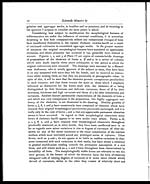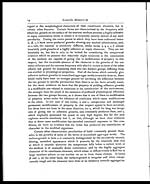Medicine - Institutions > Army health reports and medical documents > Scientific memoirs by medical officers of the Army of India > Part VIII, 1894 > 1 - Results of continued study of various forms of comma-bacilli occuring in Calcutta
(19) Page 13
Download files
Individual page:
Thumbnail gallery: Grid view | List view

Medical Officers of the Army of India.
13
normally highly curved bodies. Forms α, γ, ζ and λ belong to the first group,
and forms β, ε, and θ to the second, and in no case has a member of one
group come to present the characters proper to those of the other. Within
the limits of each group minor differences characterise the elements of
individual forms. Thus, in the first group α is characterised by the blunt-
ness, and feeble curvature of its elements, γ by their slenderness, acuteness and
higher curvature, ζ by elements resembling those of γ in their slenderness and
those of α in their defective curvature, and λ by the comparative rarity with
which it presents any elements of appreciable curvature. So, in the second
group ε and θ are respectively distinguished from γ, in the first instance by
the large, and in the second by the small, size of their elements, whilst μ is
characterised by elements of defective curvature and relative excessive thickness.
Of the forms in which a more or less stable alteration in morphological char-
acters has taken placne η, in which the elements originally were distinguished
by their very small size, relative thickness and frequently almost micrococcoid
nature, now constantly produces minute, slightly curved rods, and ι, which
originally usually produced elements more or less resembling those of α or γ,
is now characterised by thick, very highly curved or almost circular commas.
In the remaining forms no constant morphological peculiarities have been estab-
lished and variations continue to occur in no definite order in connection with
transfer from one sample of the nutrient medium to another. Altogether, then,
there is no satisfactory evidence that even very prolonged exposure to uniform,
like conditions has given rise to any general morphological assimilation in the
various forms of choleraic comma-bacilli, seeing that in the majority of in-
stances the morphological peculiarities which were present in the earlier cultures
of the series have remained practically unaltered up to the present time, and
that, in the exceptional cases in which permanent modification seems to have
been induced, this has not had the effect of unifying the form of the modified
organisms. In the case of organisms so subject to modification in form under
the influence of alterations in their environment as schizomycetes undoubtedly
are, morphological peculiarities are in one sense of little specific value. But,
on the other hand, just because of their liability to modification, we have fair
grounds to expect that any morphological differences which are originally
present between mere varieties of one and the same species as the result of
previous exposure to unlike conditions will tend to disappear under the influence of
prolonged exposure to common, like ones. Now, in the case of the group of
organisms with which we are at present dealing, we have no satisfactory evidence
that anything of this nature actually takes place and consequently the morpho-
logical evidence is adverse to the belief that we have to do with any mere
varieties.
The growths of the various forms of choleraic comma-bacilli in neutralised
agar-agar media continue moreover to differ from one another, not merely in
Set display mode to: Large image | Zoom image | Transcription
Images and transcriptions on this page, including medium image downloads, may be used under the Creative Commons Attribution 4.0 International Licence unless otherwise stated. ![]()
| Permanent URL | https://digital.nls.uk/75002059 |
|---|
| Shelfmark | IP/QB.10 |
|---|---|
| Additional NLS resources: | |




